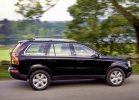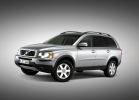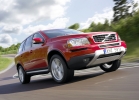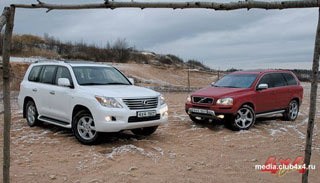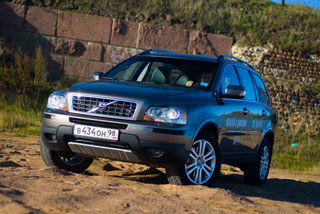VOLVO XC90 test drive since 2007 SUV
Diesel coming
 Volvo displays diesel versions of the XC90 SUV to the Russian market, as well as the XC70 and V70 station wagons. We appreciated the advantages and disadvantages of the XC90 D5 during an automotive race from Arkhangelsk to Moscow, dedicated to a diesel coming.
Volvo displays diesel versions of the XC90 SUV to the Russian market, as well as the XC70 and V70 station wagons. We appreciated the advantages and disadvantages of the XC90 D5 during an automotive race from Arkhangelsk to Moscow, dedicated to a diesel coming. Like both Swedish station wagons, diesel XC90 is equipped with a 2.4 -liter five -cylinder in -line line Volvo D5. Thanks to the new electronic control unit and a modified turbine with blades of variable geometry, the aluminum engine produces 185 hp. At the same time, the XC90 engine control system is configured in such a way that it not only provides the highest power characteristics with minimal fuel consumption, but also artificially lowers the upper limit of engine speeds with 6000 (as in front-wheel drive station wagons) up to 5000 min-1. The red zone generally begins at 4500 min-1. As a result, the extra sector is cut off, and the range of the motor is narrowed closer to the fork from 1,500 to 2700 min-1. In this zone, the maximum torque is achieved at 400 nm.
In terms of environmental friendliness, the Swedish diesel will give odds to many competitors. Even in the basic complex of the Russian market, the motor is equipped with an undergoing soot filter with a catalytic base of precious metals. Which allows all the Euro 4 harsh standards supplied to Russia to Russia with diesel engine. In addition, almost all the Volvo diesel (starting from the cheapest Optima package) will be equipped with a timer pre -heater.
 In a frosty winter morning, this option will greatly make life easier for a Russian driver. In general, the operation of diesel engines at low temperatures at Volvo paid special attention. The mathematical calculation of the cross -section of the fuel line made it possible to reduce the possibility of crystallization of paraffin. Together with a multi -level system of heating filters and fuel and fuel pipeline, this allows the Swedish diesel to be easy to start even at 37C.
In a frosty winter morning, this option will greatly make life easier for a Russian driver. In general, the operation of diesel engines at low temperatures at Volvo paid special attention. The mathematical calculation of the cross -section of the fuel line made it possible to reduce the possibility of crystallization of paraffin. Together with a multi -level system of heating filters and fuel and fuel pipeline, this allows the Swedish diesel to be easy to start even at 37C. In general, the Russian debut of their diesel engines in Volvo prepared for almost a year and a half. All this time, to check the quality of fuel, the D5 engines were running on on Russian roads. Periodically Russified Swedes were sent to the plant in the goetborg for medical examination and adaptation to Russian conditions. As a result, the quality of Russian fuel was recognized as satisfactory. But at the same time, Volvo engineers issued a very unexpected verdict: it is better to refuel away from Moscow and the Moscow region. As it turned out, as it approaches the Russian capital, the quality of Russian diesel fuel is noticeably reduced.
Among other advantages of the D5, the rally from Arkhangelsk to Arkhangelsk was designed to demonstrate the unpretentiousness of Volvo engines to Russian fuel. Therefore, on the way to Moscow, for the purity of the experiment, we specially refueled on the columns of three different oil companies. And no questions about the quality of the fuel arose. The Swedish engine consumes a Russian diesel fuel for a sweet soul, but by no means with animal appetite. With a slightly more economical driving 1300 km to Moscow, it was possible to overcome only two 65 -liner tanks: the volvo consumption in the mixed cycle is 9 liters per 100 km, but since most of the distance we went at speeds of more than 120 km/h, our motor of our XC90 with a six -speed automatic KP consumed an average of 11.4 liters per hundred. At the same time, the consumption of gasoline XC90 2.5T (taken into the run specifically for comparing fuel consumption) was one and a half times higher than more than 17 l/100 km.
 The Kholmogorsk highway is the best suited for automobile tests. It seems that you fall on a multi -kilometer auto polygon with different types of coating. Occasionally, segments of smooth as glass of fresh asphalt come across. But the basis of the Arkhangelsk tract is the shaken nomadic roads shaking the soul, which every now and then intersperson in areas with shallow and almost non -hazardous potholes for tires. On such a coating, the Volvo suspension seems a little stiff, and, despite the wide track, a short XC90 has to be constantly caught. Although, on the other hand, at a speed of 150 km/h along a similar road except on tests no one goes.
The Kholmogorsk highway is the best suited for automobile tests. It seems that you fall on a multi -kilometer auto polygon with different types of coating. Occasionally, segments of smooth as glass of fresh asphalt come across. But the basis of the Arkhangelsk tract is the shaken nomadic roads shaking the soul, which every now and then intersperson in areas with shallow and almost non -hazardous potholes for tires. On such a coating, the Volvo suspension seems a little stiff, and, despite the wide track, a short XC90 has to be constantly caught. Although, on the other hand, at a speed of 150 km/h along a similar road except on tests no one goes. Lomonosov’s path
Nine cars came out to the start of the rally in Arkhangelsk. In addition to the seven diesel ones, two Volvo with gasoline engines were taken on a trip: XC90 2.5T and XC70 3.2. The next day, having overcome more than 1300 km, all nine Volvo successfully finished the Archangelskoye estate near Moscow. The average fuel consumption for diesel cars was 11 liters per 100 km, for gasoline 17.
It is noteworthy that the route of the rally from Arkhangelsk to Arkhangelsk, passed through Kholmogory, Velsk, Vologda and Yaroslavl, almost exactly repeated the path that Mikhailo Vasilievich Lomonosov went to Moscow in 1730. And it is doubly symbolic that, on the eve of the 300th anniversary of the great Russian scientist, this path was traveled precisely at the wheel of Swedish cars! After all, it was the Swedish Royal Academy in 1760 that the first in Europe came to Lomonosov the degree of academician. So two and a half century ago, the Swedes were the first to recognize the talent of a Russian scientist. And after 250 years, his native Kholmogory became a starting point for the Russian recognition of Swedish cars with diesel engines.
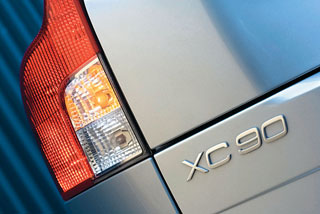 Driving
Driving The steering wheel, like most SUVs, is somewhat empty, but it is impossible to complain about the operation of automatic transmission. No extra switching or jerks. Everything is extremely clear and reasonable.
Salon
A somewhat outdated but practical design in January 2008 will be supplemented by a retractable monitor of the navigation system in the upper part of the central console.
Comfort
Inherent in diesel engines, small vibrations on the steering wheel and pedals are, of course, present, but in general the engine works softly and quietly enough.
Safety
The car is far from young, but passive security at a very high level traditional for Volvo.
Price
On average, XC90 with a diesel engine (from 1,444,800 rubles) is $ 1,500 cheaper than gasoline in a similar configuration, not to mention huge fuel savings.
Technical characteristics of Volvo XC90 D5
Dimensions, mm 34807/1898/1784
Diesel engine, 2401 cm3, 185 hp/4000 min-1
Automatic transmission, 6-speed
Dynamics 0-100 km/h, C 11.5
Maximum speed, km/h 190
Competitors BMW X5, Volkswagen Touareg TDI
Advantages and disadvantages
+ Low fuel consumption, high environmental friendliness and wide range of revolutions with the maximum torque.
- The accelerator pedal has a noticeable idle speed.
Our opinion
A solid appearance and low fuel consumption, coupled with good operational characteristics, make a diesel Volvo XC90 a real find for the Russian market, especially regional. The car, of course, costs the money that they ask for it.
Volvo displays diesel versions of the XC90 SUV to the Russian market, as well as the XC70 and V70 station wagons. We appreciated the advantages and disadvantages of the XC90 D5 during an automotive race from Arkhangelsk to Moscow, dedicated to a diesel coming.
2008 Volvo XC90 D5 Photo: Volvokak and both Swedish station wagons, diesel XC90 is equipped with a 2.4 -liter five -cylinder in -line Volvo D5 engine. Thanks to the new electronic control unit and a modified turbine with blades of variable geometry, the aluminum engine produces 185 hp. At the same time, the XC90 engine control system is configured in such a way that it not only provides the highest power characteristics with minimal fuel consumption, but also artificially lowers the upper limit of engine speeds with 6000 (as in front-wheel drive station wagons) up to 5000 min-1. The red zone generally begins at 4500 min-1. As a result, the extra sector is cut off, and the range of the motor is narrowed closer to the fork from 1,500 to 2700 min-1. In this zone, the maximum torque is achieved at 400 nm.
2008 Volvo XC90 D5 Photo: VOLVOV Plan of Environmental friendliness of the Swedish diesel will give odds to many competitors. Even in the basic complex of the Russian market, the motor is equipped with an undergoing soot filter with a catalytic base of precious metals. Which allows all the Euro 4 harsh standards supplied to Russia to Russia with diesel engine. In addition, almost all the Volvo diesel (starting from the cheapest Optima package) will be equipped with a timer pre -heater. In a frosty winter morning, this option will greatly make life easier for a Russian driver. In general, the operation of diesel engines at low temperatures at Volvo paid special attention. The mathematical calculation of the cross -section of the fuel line made it possible to reduce the possibility of crystallization of paraffin. Together with a multi -level system of heating filters and fuel and fuel pipeline, this allows the Swedish diesel to be easy to start even at 37C.
2008 Volvo XC90 D5 Photo: VOLVOVs for the Russian debut of their diesel engines in Volvo were prepared for almost a year and a half. All this time, to check the quality of fuel, the D5 engines were running on on Russian roads. Periodically Russified Swedes were sent to the plant in the goetborg for medical examination and adaptation to Russian conditions. As a result, the quality of Russian fuel was recognized as satisfactory. But at the same time, Volvo engineers issued a very unexpected verdict: it is better to refuel away from Moscow and the Moscow region. As it turned out, as it approaches the Russian capital, the quality of Russian diesel fuel is noticeably reduced.
Among other advantages of the D5, the rally from Arkhangelsk to Arkhangelsk was designed to demonstrate the unpretentiousness of Volvo engines to Russian fuel. Therefore, on the way to Moscow, for the purity of the experiment, we specially refueled on the columns of three different oil companies. And no questions about the quality of the fuel arose. The Swedish engine consumes a Russian diesel fuel for a sweet soul, but by no means with animal appetite. With a slightly more economical driving 1300 km to Moscow, it was possible to overcome only two 65 -liner tanks: the volvo consumption in the mixed cycle is 9 liters per 100 km, but since most of the distance we went at speeds of more than 120 km/h, our motor of our XC90 with a six -speed automatic KP consumed an average of 11.4 liters per hundred. At the same time, the consumption of gasoline XC90 2.5T (taken into the run specifically for comparing fuel consumption) was one and a half times higher than more than 17 l/100 km.
The Kholmogorsk highway is the best suited for automobile tests. It seems that you fall on a multi -kilometer auto polygon with different types of coating. Occasionally, segments of smooth as glass of fresh asphalt come across. But the basis of the Arkhangelsk tract is the shaken nomadic roads shaking the soul, which every now and then intersperson in areas with shallow and almost non -hazardous potholes for tires. On such a coating, the Volvo suspension seems a little stiff, and, despite the wide track, a short XC90 has to be constantly caught. Although, on the other hand, at a speed of 150 km/h along a similar road except on tests no one goes.
Lomonosov’s path
2008 Volvo XC90 D5 Photo: Volvon Starting Auto Rounder in Arkhangelsk got nine cars. In addition to the seven diesel ones, two Volvo with gasoline engines were taken on a trip: XC90 2.5T and XC70 3.2. The next day, having overcome more than 1300 km, all nine Volvo successfully finished the Archangelskoye estate near Moscow. The average fuel consumption for diesel cars was 11 liters per 100 km, for gasoline 17.
It is noteworthy that the route of the rally from Arkhangelsk to Arkhangelsk, passed through Kholmogory, Velsk, Vologda and Yaroslavl, almost exactly repeated the path that Mikhailo Vasilievich Lomonosov went to Moscow in 1730. And it is doubly symbolic that, on the eve of the 300th anniversary of the great Russian scientist, this path was traveled precisely at the wheel of Swedish cars! After all, it was the Swedish Royal Academy in 1760 that the first in Europe came to Lomonosov the degree of academician. So two and a half century ago, the Swedes were the first to recognize the talent of a Russian scientist. And after 250 years, his native Kholmogory became a starting point for the Russian recognition of Swedish cars with diesel engines.
Driving
The steering wheel, like most SUVs, is somewhat empty, but it is impossible to complain about the operation of automatic transmission. No extra switching or jerks. Everything is extremely clear and reasonable.
Salon
A somewhat outdated but practical design in January 2008 will be supplemented by a retractable monitor of the navigation system in the upper part of the central console.
Comfort
Inherent in diesel engines, small vibrations on the steering wheel and pedals are, of course, present, but in general the engine works softly and quietly enough.
Safety
The car is far from young, but passive security at a very high level traditional for Volvo.
Price
On average, XC90 with a diesel engine (from 1,444,800 rubles) is $ 1,500 cheaper than gasoline in a similar configuration, not to mention huge fuel savings.
Technical characteristics of the Volvo XC90 D5 dimensions, mm 34807/1898/1784
Diesel engine, 2401 cm3, 185 hp/4000 min-1
Automatic transmission, 6-speed
Dynamics 0-100 km/h, C 11.5
Maximum speed, km/h 190
Competitors BMW X5, Volkswagen Touareg TDI
Advantages and disadvantages
+ Low fuel consumption, high environmental friendliness and wide range of revolutions with the maximum torque.
- The accelerator pedal has a noticeable idle speed.
Our opinion
A solid appearance and low fuel consumption, coupled with good operational characteristics, make a diesel Volvo XC90 a real find for the Russian market, especially regional. The car, of course, costs the money that they ask for it.
Volvo displays diesel versions of the XC90 SUV to the Russian market, as well as the XC70 and V70 station wagons. We appreciated the advantages and disadvantages of the XC90 D5 during an automotive race from Arkhangelsk to Moscow, dedicated to a diesel coming.
2008 Volvo XC90 D5 Photo: Volvokak and both Swedish station wagons, diesel XC90 is equipped with a 2.4 -liter five -cylinder in -line Volvo D5 engine. Thanks to the new electronic control unit and a modified turbine with blades of variable geometry, the aluminum engine produces 185 hp. At the same time, the XC90 engine control system is configured in such a way that it not only provides the highest power characteristics with minimal fuel consumption, but also artificially lowers the upper limit of engine speeds with 6000 (as in front-wheel drive station wagons) up to 5000 min-1. The red zone generally begins at 4500 min-1. As a result, the extra sector is cut off, and the range of the motor is narrowed closer to the fork from 1,500 to 2700 min-1. In this zone, the maximum torque is achieved at 400 nm.
2008 Volvo XC90 D5 Photo: VOLVOV Plan of Environmental friendliness of the Swedish diesel will give odds to many competitors. Even in the basic complex of the Russian market, the motor is equipped with an undergoing soot filter with a catalytic base of precious metals. Which allows all the Euro 4 harsh standards supplied to Russia to Russia with diesel engine. In addition, almost all the Volvo diesel (starting from the cheapest Optima package) will be equipped with a timer pre -heater. In a frosty winter morning, this option will greatly make life easier for a Russian driver. In general, the operation of diesel engines at low temperatures at Volvo paid special attention. The mathematical calculation of the cross -section of the fuel line made it possible to reduce the possibility of crystallization of paraffin. Together with a multi -level system of heating filters and fuel and fuel pipeline, this allows the Swedish diesel to be easy to start even at 37C.
2008 Volvo XC90 D5 Photo: VOLVOVs for the Russian debut of their diesel engines in Volvo were prepared for almost a year and a half. All this time, to check the quality of fuel, the D5 engines were running on on Russian roads. Periodically Russified Swedes were sent to the plant in the goetborg for medical examination and adaptation to Russian conditions. As a result, the quality of Russian fuel was recognized as satisfactory. But at the same time, Volvo engineers issued a very unexpected verdict: it is better to refuel away from Moscow and the Moscow region. As it turned out, as it approaches the Russian capital, the quality of Russian diesel fuel is noticeably reduced.
Among other advantages of the D5, the rally from Arkhangelsk to Arkhangelsk was designed to demonstrate the unpretentiousness of Volvo engines to Russian fuel. Therefore, on the way to Moscow, for the purity of the experiment, we specially refueled on the columns of three different oil companies. And no questions about the quality of the fuel arose. The Swedish engine consumes a Russian diesel fuel for a sweet soul, but by no means with animal appetite. With a slightly more economical driving 1300 km to Moscow, it was possible to overcome only two 65 -liner tanks: the volvo consumption in the mixed cycle is 9 liters per 100 km, but since most of the distance we went at speeds of more than 120 km/h, our motor of our XC90 with a six -speed automatic KP consumed an average of 11.4 liters per hundred. At the same time, the consumption of gasoline XC90 2.5T (taken into the run specifically for comparing fuel consumption) was one and a half times higher than more than 17 l/100 km.
The Kholmogorsk highway is the best suited for automobile tests. It seems that you fall on a multi -kilometer auto polygon with different types of coating. Occasionally, segments of smooth as glass of fresh asphalt come across. But the basis of the Arkhangelsk tract is the shaken nomadic roads shaking the soul, which every now and then intersperson in areas with shallow and almost non -hazardous potholes for tires. On such a coating, the Volvo suspension seems a little stiff, and, despite the wide track, a short XC90 has to be constantly caught. Although, on the other hand, at a speed of 150 km/h along a similar road except on tests no one goes.
Lomonosov’s path
2008 Volvo XC90 D5 Photo: Volvon Starting Auto Rounder in Arkhangelsk got nine cars. In addition to the seven diesel ones, two Volvo with gasoline engines were taken on a trip: XC90 2.5T and XC70 3.2. The next day, having overcome more than 1300 km, all nine Volvo successfully finished the Archangelskoye estate near Moscow. The average fuel consumption for diesel cars was 11 liters per 100 km, for gasoline 17.
It is noteworthy that the route of the rally from Arkhangelsk to Arkhangelsk, passed through Kholmogory, Velsk, Vologda and Yaroslavl, almost exactly repeated the path that Mikhailo Vasilievich Lomonosov went to Moscow in 1730. And it is doubly symbolic that, on the eve of the 300th anniversary of the great Russian scientist, this path was traveled precisely at the wheel of Swedish cars! After all, it was the Swedish Royal Academy in 1760 that the first in Europe came to Lomonosov the degree of academician. So two and a half century ago, the Swedes were the first to recognize the talent of a Russian scientist. And after 250 years, his native Kholmogory became a starting point for the Russian recognition of Swedish cars with diesel engines.
Driving
The steering wheel, like most SUVs, is somewhat empty, but it is impossible to complain about the operation of automatic transmission. No extra switching or jerks. Everything is extremely clear and reasonable.
Salon
A somewhat outdated but practical design in January 2008 will be supplemented by a retractable monitor of the navigation system in the upper part of the central console.
Comfort
Inherent in diesel engines, small vibrations on the steering wheel and pedals are, of course, present, but in general the engine works softly and quietly enough.
Safety
The car is far from young, but passive security at a very high level traditional for Volvo.
Price
On average, XC90 with a diesel engine (from 1,444,800 rubles) is $ 1,500 cheaper than gasoline in a similar configuration, not to mention huge fuel savings.
Technical characteristics of the Volvo XC90 D5 dimensions, mm 34807/1898/1784
Diesel engine, 2401 cm3, 185 hp/4000 min-1
Automatic transmission, 6-speed
Dynamics 0-100 km/h, C 11.5
Maximum speed, km/h 190
Competitors BMW X5, Volkswagen Touareg TDI
Advantages and disadvantages
+ Low fuel consumption, high environmental friendliness and wide range of revolutions with the maximum torque.
- The accelerator pedal has a noticeable idle speed.
Our opinion
A solid appearance and low fuel consumption, coupled with good operational characteristics, make a diesel Volvo XC90 a real find for the Russian market, especially regional. The car, of course, costs the money that they ask for it.
Source: Magazine 5 wheel [December 2007]

